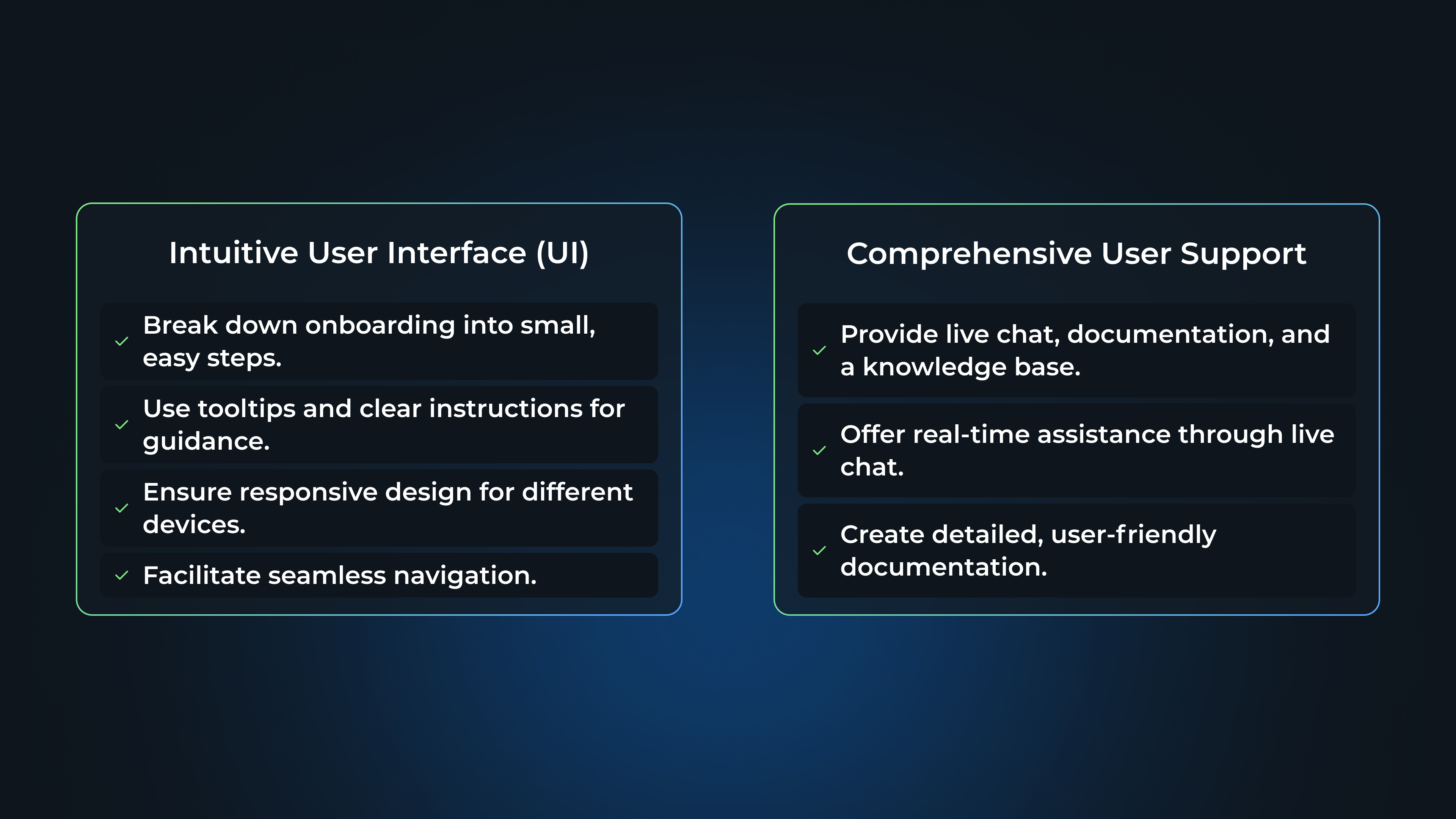In today’s competitive market, user onboarding and retention are crucial for the success of any SaaS company. We at WeSoftYou understand the importance of effectively onboarding new users and retaining existing customers. With our expertise in software development, we have identified the best practices that can help you optimize your user onboarding and retention strategies. Let’s dive deeper into this topic and explore the key elements of successful user onboarding.
The Importance of User Onboarding and Retention
User onboarding and retention are integral to the success of SaaS companies, playing distinct yet interconnected roles. User onboarding is the initial process of guiding new users through product introduction, ensuring a seamless and positive experience. An effective onboarding strategy is essential for helping users comprehend the product’s value, features, and problem-solving capabilities. Providing a clear and intuitive user interface enhances user understanding, reduces frustration, and boosts adoption rates.
The user onboarding journey comprises various stages, starting with the initial interaction where users acquaint themselves with key features. This stage is pivotal in capturing attention and igniting interest. Subsequent stages involve delivering in-depth information and guidance through interactive tutorials, tooltips, or personalized onboarding emails. Ongoing support and education empower users to confidently explore and utilize the product, turning onboarding into a continuous and evolving process that aligns with product updates.
User retention emerges as a linchpin for sustained growth in the SaaS landscape. While acquiring new customers is crucial, retaining existing ones is equally vital. Repeat customers contribute not only to revenue but also serve as brand advocates, referring others to the product. The cost-effectiveness of user retention lies in the established relationship with existing customers, as opposed to the expenses associated with acquiring new ones. Furthermore, user retention is linked to customer loyalty, resulting from positive experiences and consistent value delivery. Loyal customers foster long-term relationships, increased customer lifetime value, and opportunities for upselling or cross-selling.
Beyond financial considerations, user retention is a conduit for valuable feedback and insights. Loyal customers, satisfied with the product, are more likely to provide feedback, share experiences, and suggest improvements. Actively incorporating customer feedback into the product development process ensures ongoing relevance and alignment with evolving user needs. In conclusion, effective onboarding and retention strategies are essential for SaaS success, creating a pathway not just for customer acquisition but for sustained engagement, satisfaction, and loyalty.
Key Elements of Successful User Onboarding
When it comes to user onboarding, there are several key elements that can significantly impact the success of your efforts. Let’s explore two crucial elements that can make a difference.

Intuitive User Interface (UI)
From our experience, we have found that an intuitive user interface is paramount to successful onboarding. Simplify the onboarding process by breaking it down into small, easy-to-understand steps. Use tooltips, interactive walkthroughs, and clear instructions to guide users through the initial setup. Additionally, providing a responsive design that adapts to different devices enhances the user experience.
An intuitive user interface not only helps users navigate through the onboarding process seamlessly but also sets the tone for their entire experience with your product. By designing an interface that is visually appealing and user-friendly, you can create a positive first impression and establish trust with your users. Consider incorporating visual cues such as icons, colors, and typography that align with your brand identity to create a cohesive and memorable onboarding experience.
Furthermore, it is essential to consider the accessibility of your user interface. Ensure that users with disabilities can easily navigate and interact with your product by following accessibility guidelines and standards. By making your onboarding process inclusive, you can cater to a wider audience and demonstrate your commitment to providing an exceptional user experience for all.
Comprehensive User Support
No matter how intuitive your interface is, users may still need assistance during their onboarding journey. Incorporate various channels for user support, including live chat, comprehensive documentation, and an online knowledge base. Timely and helpful support can eliminate roadblocks for users and ensure a smooth transition into using your product.
When it comes to user support, it is crucial to provide multiple avenues for users to seek help. Live chat support allows users to receive real-time assistance, addressing their queries and concerns promptly. This personalized approach can make users feel valued and supported throughout their onboarding process.
In addition to live chat, comprehensive documentation serves as a valuable resource for users to find answers to common questions and learn more about your product’s features and functionalities. By creating detailed and easy-to-understand documentation, you empower users to become self-sufficient and explore your product at their own pace.
An online knowledge base is another effective way to provide comprehensive user support. This centralized repository of information can include tutorials, FAQs, troubleshooting guides, and best practices. By organizing information in a structured and searchable manner, users can quickly find the answers they need, saving time and frustration.
Remember, user support is an ongoing process. Continuously gather feedback from users and iterate on your support channels to address any pain points or areas of improvement. By actively listening to your users’ needs and providing exceptional support, you can foster long-term customer loyalty and advocacy.
Strategies for Enhancing User Retention
Once you have successfully onboarded your users, it’s crucial to focus on strategies that promote user retention. Let’s discuss two effective strategies that can help you keep your customers engaged.
Regular User Engagement Implementation
User engagement is the key to increasing customer retention. Regularly engage with your users through personalized email campaigns, in-app notifications, and social media interactions. Provide valuable content, such as industry insights, best practices, and product updates, to keep users informed and engaged with your product.
When it comes to personalized email campaigns, make sure to segment your user base and tailor your messages to specific user groups. This will allow you to deliver content that is relevant and valuable to each segment, increasing the chances of user engagement.
In-app notifications can be a powerful tool for user engagement. Use them to deliver timely and personalized messages, such as reminders, new feature announcements, or special offers. By keeping your users informed and engaged within the app, you create a sense of value and encourage them to continue using your product.
Social media interactions are another great way to engage with your users. Actively participate in relevant industry discussions, share useful content, and respond to user comments and inquiries. By building a strong online presence and fostering a sense of community, you can create a loyal user base that is more likely to stick around.
Utilizing Feedback for Continuous Improvement
Feedback from your users is a valuable resource for improving your product and enhancing user retention. Gather feedback through surveys, user interviews, and analytics tools. Actively listen to your users’ suggestions and concerns and implement changes accordingly. When users feel heard and see their feedback being implemented, they are more likely to stick with your product.
Surveys can provide valuable insights into user preferences, pain points, and overall satisfaction. Use tools like Net Promoter Score (NPS) surveys to gauge user loyalty and identify areas for improvement. Additionally, consider conducting user interviews to gain deeper insights into user experiences and uncover hidden opportunities for enhancing retention.
Analytics tools can help you track user behavior and identify patterns that may impact retention. By analyzing user data, you can identify areas of your product that may need improvement or optimization. For example, if you notice a high drop-off rate at a specific point in the user journey, you can investigate further and make necessary adjustments to improve user retention.
Remember, user feedback should not be seen as a one-time activity. Continuously seek feedback from your users and iterate on your product based on their input. By showing your users that their opinions matter and actively working to address their needs, you can foster a strong sense of loyalty and increase user retention.
Measuring the Success of Your Onboarding and Retention Efforts
Measuring the effectiveness of your user onboarding and retention efforts is essential for optimizing your strategies. Let’s explore the key performance indicators (KPIs) that can help you track your progress.
Metrics for Evaluating User Onboarding
When it comes to onboarding, there are several key metrics that can provide valuable insights into the success of your efforts:
-
User Activation Rate: Measures the percentage of users completing essential onboarding steps. Indicates how effectively users are guided through the process, ensuring full engagement with the product or service.
-
Time to First Value: Measures the time users take to experience the core benefit or value. A shorter time suggests an efficient onboarding process, helping users quickly understand and derive value.
-
User Drop-off Rate: Measures the percentage of users abandoning onboarding before completion. Identifies obstacles causing drop-offs, enabling improvements and optimization of the onboarding process.
Metrics for Evaluating User Retention
Measuring user retention is equally important as onboarding, as it helps you understand how well you are able to retain and engage your existing customer base. There are several metrics that can provide valuable insights into user retention:
- Churn Rate: Measures the percentage of customers discontinuing product or service usage within a specific period. Highlights potential issues with customer satisfaction or areas for improvement in the product or service.
-
Customer Lifetime Value (CLTV): Measures the total revenue generated by a customer throughout their entire relationship with a business. Provides insights into customer profitability, helping identify opportunities to enhance loyalty and increase lifetime value.
-
Net Promoter Score (NPS): Measures the likelihood of customers recommending a product or service to others. A high NPS indicates strong customer loyalty and satisfaction, while a low score may highlight areas for improvement. Regular tracking helps gauge overall customer sentiment and advocacy.
In conclusion, measuring the success of your onboarding and retention efforts is crucial for optimizing your strategies and ensuring the long-term success of your business. By tracking key performance indicators for onboarding and user retention, you can identify areas for improvement, make data-driven decisions, and ultimately enhance the overall user experience.
Challenges in User Onboarding and Retention
Despite your best efforts, you may encounter challenges during the user onboarding and retention process. Let’s discuss two common challenges and how to overcome them.
User Resistance to Change
When introducing a new product, users may resist change due to familiarity with existing solutions. This resistance can stem from a fear of the unknown or a reluctance to invest time and effort in learning something new. To overcome this challenge, it is crucial to focus on highlighting the unique value proposition of your product.
Start by clearly communicating the benefits and advantages that your product offers over the existing solutions. Show users how your product can solve their pain points and make their lives easier. Provide compelling examples and case studies that demonstrate the positive impact your product can have on their workflow or daily tasks.
In addition to highlighting the benefits, it is essential to offer resources and support to help users transition smoothly. Provide comprehensive documentation, tutorials, and training materials that guide users through the onboarding process. Offer responsive customer support to address any questions or concerns they may have.
Another effective strategy is to emphasize the benefits users will gain by adopting your solution. Showcase success stories and testimonials from satisfied customers who have experienced positive outcomes after implementing your product. By illustrating the potential rewards, you can help users overcome their resistance to change and motivate them to give your product a chance.
High User Expectations
As SaaS users become more experienced, their expectations increase. They have likely used various software solutions in the past and have developed a set of standards and preferences. Managing these high expectations requires continuous improvement and innovation.
One way to meet and exceed user expectations is by regularly releasing product updates and new features. This demonstrates your commitment to enhancing the user experience and addressing their evolving needs. Keep a pulse on the market and industry trends to identify areas where your product can be improved or expanded.
Additionally, soliciting and incorporating user feedback is crucial for managing high expectations. Actively seek input from your users through surveys, feedback forms, or user testing sessions. Analyze the feedback and identify common pain points or feature requests. Use this information to prioritize your product roadmap and make data-driven decisions.
Furthermore, consider implementing a user community or forum where users can share their experiences, exchange ideas, and provide suggestions. This not only fosters a sense of belonging but also allows users to contribute to the product’s development and feel heard.
Lastly, invest in continuous user education and engagement. Provide regular updates on new features, product tips, and best practices through newsletters, webinars, or blog posts. By empowering users with knowledge and helping them maximize the value of your product, you can further manage their expectations and strengthen their loyalty.
Future Trends in SaaS User Onboarding and Retention
The SaaS industry is constantly evolving, and it’s essential to stay ahead of the curve. Let’s explore two future trends that will impact user onboarding and retention.
AI in User Onboarding
Artificial intelligence (AI) is revolutionizing user onboarding. AI-powered chatbots can provide personalized guidance and support to users, creating a more engaging and interactive experience. These chatbots can analyze user behavior data, such as their preferences, usage patterns, and feedback, to offer tailored recommendations and assistance. By leveraging AI, SaaS companies can streamline the onboarding process, reduce friction, and increase user satisfaction.
Imagine a scenario where a user signs up for a new SaaS product. Instead of being greeted with a generic welcome email, they receive a personalized message from an AI chatbot. The chatbot asks them about their goals, preferences, and any challenges they may be facing. Based on this information, the chatbot provides step-by-step instructions on how to get started and offers relevant resources and tips along the way.
Furthermore, AI can also play a crucial role in user training and education. By analyzing user interactions and identifying areas where users struggle or get stuck, AI-powered systems can automatically generate targeted tutorials or video guides to help users overcome these obstacles. This proactive approach to user onboarding not only enhances the user experience but also increases product adoption rates and reduces churn.
Personalization in User Retention
Personalization is becoming increasingly important for user retention. In today’s digital landscape, users expect tailored experiences that cater to their unique needs and preferences. By personalizing the user experience based on individual data, SaaS companies can enhance engagement and build stronger relationships with their users.
One way to achieve personalization is through data analytics and segmentation strategies. By analyzing user data, such as demographics, usage patterns, and feedback, SaaS companies can divide their user base into distinct segments. Each segment can then receive targeted content, recommendations, and offers that align with their specific needs and interests.
For example, imagine a SaaS company that offers project management software. Through data analysis, they identify two distinct user segments: freelancers and enterprise teams. The company can then tailor their onboarding and retention strategies accordingly. Freelancers may receive content and resources focused on solo project management, while enterprise teams may receive content and resources on collaboration and team coordination.
Another way to personalize the user experience is through dynamic content. By leveraging user data and behavioral tracking, SaaS companies can dynamically adjust the content displayed to users based on their preferences and interactions. This can include personalized recommendations, targeted messaging, and customized user interfaces.
In conclusion, user onboarding and retention are critical for the success of SaaS companies. By following best practices, such as creating an intuitive interface, providing comprehensive user support, implementing user engagement strategies, and utilizing feedback, you can optimize your onboarding and retention efforts. However, it’s important to stay ahead of the curve and embrace future trends like the rise of AI in user onboarding and the growing importance of personalization in user retention. These trends have the potential to revolutionize the way SaaS companies engage with their users and drive long-term success.
As a software development company with a proven track record, Wesoftyou is here to help you navigate these challenges and achieve success. Ready to optimize your SaaS user onboarding and retention? Contact WeSoftYou for a free consultation or project estimation and let us help you achieve success.
FAQ
User onboarding is crucial for SaaS companies as it helps new users understand the value of their product and increases adoption rates. It sets the stage for a positive user experience and drives customer satisfaction.
User retention is vital for the sustainable growth of SaaS companies. Repeat customers not only contribute to revenue but also act as brand advocates, referring others to your product. High user retention indicates user satisfaction and a strong product-market fit.
When evaluating user retention, important metrics to measure include churn rate, customer lifetime value (CLTV), and net promoter score (NPS). These metrics provide insights into the health of your customer base and help you identify strategies to decrease churn and increase loyalty.





















